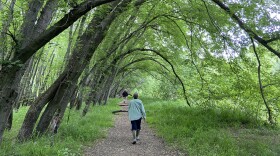As the forest turns to gold and the days grow shorter, something wild — and sweet — is happening in the understory. The berry bushes are heavy, the apples are ripe, and the winterberry is bright red. The woods have become nature’s candy store.
For most people, “mast” is a tall pole on a ship. But mast in the forest has nothing to do with sailing. It’s the term for all the nuts, seeds, and fruits that woody trees and shrubs produce.
There are two kinds of mast: hard mast and soft mast. Hard mast includes acorns, beechnuts, and hickory nuts . . . the crunchy stuff. But let’s not forget about the soft mast: the berries and fruits that ripen through late summer and fall.
These fruits are essential for wildlife. Robins, bluebirds, and waxwings gorge on dogwood berries and viburnums. Bears bulk up on black cherries, elderberries, and mountain ash. Even turkeys and grouse peck at winterberries when the snow starts.
What’s fascinating is how well-timed all this is. Each plant ripens in sequence, almost like a conveyor belt of fruit: serviceberries and blackberries in midsummer, dogwoods in September, and winterberry holding on into December. It’s nature’s way of keeping the pantry stocked.

And those bright red and purple fruits? They’re not just pretty. They’re signals to birds. The berries practically say, “Eat me!”
It’s a great trade: the bird gets a meal, and the plant gets a free delivery service. The seeds pass through the bird and get dropped somewhere new — fertilizer included!
Unlike the boom-and-bust cycles of acorn crops, soft mast tends to be a little more reliable; a steady trickle of fruit most years. But that’s changing a bit. Climate shifts, late frosts, and summer droughts can all affect when and how much fruit ripens.
And for some species, that timing really matters. Fall berries fuel migration and persistent fruits (the ones that hang onto shrubs or trees into winter) are critical for birds like cedar waxwings that stay in New Hampshire year-round. They rely almost entirely on fruit, and they won’t visit bird feeders.
Berries feed the mammals too. Mice, foxes, raccoons, and opossums all forage on fallen fruit, cleaning up the forest floor and spreading seeds as they go.
And of course, berries feed us! Come November, some folks pull on waders and head into a bog to gather wild cranberries, perfect for baking, or for homemade Thanksgiving cranberry sauce.
So next time you spot a flock of robins tugging at a winterberry bush, or cedar waxwings stripping a mountain ash, you’re watching a seasonal exchange millions of years in the making, one that connects birds, mammals, and even people through the forest’s sweetest offerings.
The forest is full of those relationships; quiet, dependable, and easy to miss unless you stop to look. It’s nature’s version of cooperation: sweetness for survival.
Something Wild is a joint production of NH Audubon, the Forest Society, and NHPR.










